The video game industry is built on progress. Both creators and fans alike are always looking for the next big step, even when what we have currently is fairly impressive. The current generation of consoles has brought VR to the masses, is introducing 4K gaming to console users, and has stepped up visual fidelity to a point where it’s difficult to imagine anything better. Yet, even while the Xbox One and PS4 are constantly building momentum, many are beginning to wonder when we can expect the next evolution.
We already know that Microsoft is putting out their Project Scorpio later this year, so there will be some time before we see a next major step from them. Nintendo is kicking off the next generation with its own new console, the Switch, this March. So it’s no surprise that eyes are turning to Sony and the inevitable PS5.
Before we can predict when we might see Sony’s next, bona fide new console, we have to take a look at the past. Console life-cycles have changed quite a bit over the years. From the first iteration of the PlayStation (’94) to the PlayStation 2 (’00), there was a six year gap. Thanks to the insane popularity of the PS2 and the momentum it generated, it went on to become the highest selling console of all time, surpassing the next highest selling home console by over 50 million units. Still, the life-cycle moved on, and six years after we were introduced to the PS3 (’06).
The PS3 struggled a bit out of the gates, especially since it came a year after the Xbox 360 and Sony’s much higher price wasn’t doing the hardware any favors. Yet it held strong, and Sony had ample time to work on what would come next. So in 2013, seven years after the release of its predecessor, Sony released the PS4. It was more than just an upgraded version of previous consoles in the family, though; it changed the way Sony approached its gaming hardware, and that is causing a huge ripple in the life-cycle.
Prior to the PS4 and the Xbox One, gaming consoles each used proprietary hardware. They ran on different systems, which is why games were often quite different depending on where you played them, and why development time on new systems sometimes took so long. However, with the current generation, gaming consoles are using an X86 architecture, bringing them not only more in line with gaming PCs, but also making advancements in tech much easier, and quicker.
Just three years after the release of the PS4, we received the PS4 Pro, which, in the past, would’ve just been an entirely new console. This was the first taste of just how quickly console makers can present a new product to players at this point. Sure, it’s not as big a jump as the PS1 to PS2 in terms of graphics, but as technology continues to become more and more advanced, those benchmarks aren’t going to be as grand as they were in the past.
This makes the prospect of a PS5 coming in sooner rather than later a strong possibility. Sony has, for the most part, released their consoles to be in line with the competition. The one time that they didn’t was with the PS3, and that almost cost them dearly. Microsoft’s Project Scorpio is supposed to be the strongest gaming console ever made, something that you can bet dollars to donuts won’t sit unchallenged for very long. Whether the answer to the upgraded Xbox One’s release will be the PS5 is not known, but it’s a certainty that something will come from Sony.
While many are considering the PS4 Pro the halfway mark for the current generation’s life cycle – placing the run at six years – we may be going back to the five year gap that Sony’s ecosystem first used. With advancements in graphical capabilities, memory, and game development picking up pace, it’s not difficult to imagine Sony keeping up and putting out the PS5 within the next two years, much to the surprise of fans and competitors. It’s definitely within the realm of possibility if history is anything to go by.

